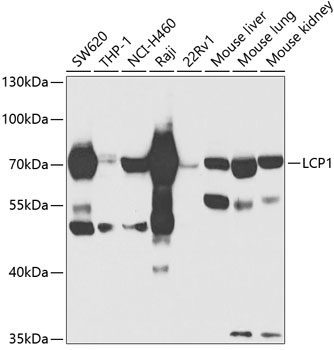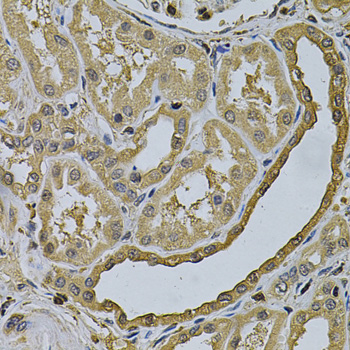Cell Biology Antibodies 4
Anti-LCP1 Antibody (CAB13504)
- SKU:
- CAB13504
- Product Type:
- Antibody
- Reactivity:
- Human
- Reactivity:
- Mouse
- Host Species:
- Rabbit
- Isotype:
- IgG
- Antibody Type:
- Polyclonal Antibody
- Research Area:
- Cell Biology
Description
| Antibody Name: | Anti-LCP1 Antibody |
| Antibody SKU: | CAB13504 |
| Antibody Size: | 20uL, 50uL, 100uL |
| Application: | WB IHC |
| Reactivity: | Human, Mouse |
| Host Species: | Rabbit |
| Immunogen: | Recombinant fusion protein containing a sequence corresponding to amino acids 368-627 of human LCP1 (NP_002289.2). |
| Application: | WB IHC |
| Recommended Dilution: | WB 1:500 - 1:2000 IHC 1:50 - 1:200 |
| Reactivity: | Human, Mouse |
| Positive Samples: | SW620, THP-1, NCI-H460, Raji, 22Rv1, Mouse liver, Mouse lung, Mouse kidney |
| Immunogen: | Recombinant fusion protein containing a sequence corresponding to amino acids 368-627 of human LCP1 (NP_002289.2). |
| Purification Method: | Affinity purification |
| Storage Buffer: | Store at -20'C. Avoid freeze / thaw cycles. Buffer: PBS with 0.02% sodium azide, 50% glycerol, pH7.3. |
| Isotype: | IgG |
| Sequence: | ANLF NRYP ALHK PENQ DIDW GALE GETR EERT FRNW MNSL GVNP RVNH LYSD LSDA LVIF QLYE KIKV PVDW NRVN KPPY PKLG GNMK KLEN CNYA VELG KNQA KFSL VGIG GQDL NEGN RTLT LALI WQLM RRYT LNIL EEIG GGQK VNDD IIVN WVNE TLRE AKKS SSIS SFKD PKIS TSLP VLDL IDAI QPGS INYD LLKT ENLN DDEK LNNA KYAI SMAR KIGA RVYA LPED LVEV NPKM VMTV FACL MGKG MKRV |
| Gene ID: | 3936 |
| Uniprot: | P13796 |
| Cellular Location: | Cell junction, Cell projection, Cytoplasm, Cytoplasmic side, Peripheral membrane protein, cytoskeleton, ruffle membrane |
| Calculated MW: | 21kDa/70kDa |
| Observed MW: | 70kDa |
| Synonyms: | LCP1, CP64, HEL-S-37, L-PLASTIN, LC64P, LPL, PLS2, plastin-2 |
| Background: | Plastins are a family of actin-binding proteins that are conserved throughout eukaryote evolution and expressed in most tissues of higher eukaryotes. In humans, two ubiquitous plastin isoforms (L and T) have been identified. Plastin 1 (otherwise known as Fimbrin) is a third distinct plastin isoform which is specifically expressed at high levels in the small intestine. The L isoform is expressed only in hemopoietic cell lineages, while the T isoform has been found in all other normal cells of solid tissues that have replicative potential (fibroblasts, endothelial cells, epithelial cells, melanocytes, etc.). However, L-plastin has been found in many types of malignant human cells of non-hemopoietic origin suggesting that its expression is induced accompanying tumorigenesis in solid tissues. |
| UniProt Protein Function: | L-plastin: Actin-binding protein. Plays a role in the activation of T-cells in response to costimulation through TCR/CD3 and CD2 or CD28. Modulates the cell surface expression of IL2RA/CD25 and CD69. Monomer. Interacts with AIF1. Detected in intestinal microvilli, hair cell stereocilia, and fibroblast filopodia, in spleen and other lymph node-containing organs. Expressed in peripheral blood T- lymphocytes, neutrophils, monocytes, B-lymphocytes, and myeloid cells. |
| UniProt Protein Details: | Protein type:Motility/polarity/chemotaxis; Actin-binding Chromosomal Location of Human Ortholog: 13q14.3 Cellular Component: actin cytoskeleton; actin filament; actin filament bundle; cytoplasm; cytosol; extracellular space; filopodium; focal adhesion; plasma membrane; podosome; ruffle; stress fiber Molecular Function:actin filament binding; GTPase binding Biological Process: actin filament bundle formation; cell migration; extracellular matrix disassembly; regulation of intracellular protein transport; T cell activation during immune response |
| NCBI Summary: | Plastins are a family of actin-binding proteins that are conserved throughout eukaryote evolution and expressed in most tissues of higher eukaryotes. In humans, two ubiquitous plastin isoforms (L and T) have been identified. Plastin 1 (otherwise known as Fimbrin) is a third distinct plastin isoform which is specifically expressed at high levels in the small intestine. The L isoform is expressed only in hemopoietic cell lineages, while the T isoform has been found in all other normal cells of solid tissues that have replicative potential (fibroblasts, endothelial cells, epithelial cells, melanocytes, etc.). However, L-plastin has been found in many types of malignant human cells of non-hemopoietic origin suggesting that its expression is induced accompanying tumorigenesis in solid tissues. [provided by RefSeq, Jul 2008] |
| UniProt Code: | P13796 |
| NCBI GenInfo Identifier: | 308153685 |
| NCBI Gene ID: | 3936 |
| NCBI Accession: | P13796.6 |
| UniProt Secondary Accession: | P13796,Q5TBN4, B2R613, B4DUA0, |
| UniProt Related Accession: | P13796 |
| Molecular Weight: | 21,792 Da |
| NCBI Full Name: | Plastin-2 |
| NCBI Synonym Full Names: | lymphocyte cytosolic protein 1 |
| NCBI Official Symbol: | LCP1 |
| NCBI Official Synonym Symbols: | LPL; CP64; PLS2; LC64P; HEL-S-37; L-PLASTIN |
| NCBI Protein Information: | plastin-2 |
| UniProt Protein Name: | Plastin-2 |
| UniProt Synonym Protein Names: | L-plastin; LC64P; Lymphocyte cytosolic protein 1; LCP-1 |
| Protein Family: | Larval cuticle protein |
| UniProt Gene Name: | LCP1 |
| UniProt Entry Name: | PLSL_HUMAN |
View AllClose








